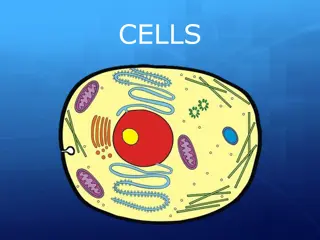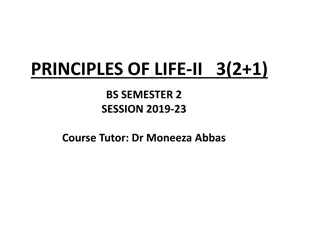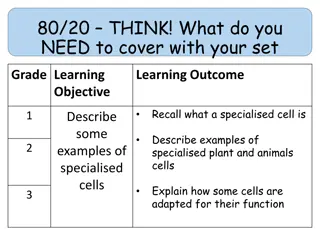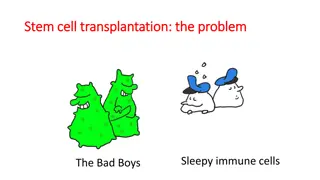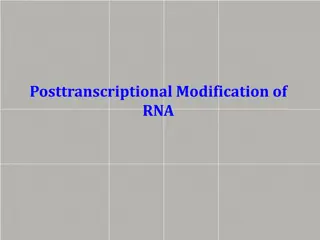Comparison of Eukaryotic and Prokaryotic Cells in Cell Biology
Cells are the fundamental units of life, but viruses are an exception as they lack cells. Eukaryotic cells have a defined nucleus with a nuclear membrane housing chromosomes, while prokaryotic cells lack a membrane-bound nucleus and other organelles. Eukaryotic cells are larger, containing membrane-bound organelles like mitochondria, endoplasmic reticulum, and chloroplasts. On the other hand, prokaryotic cells, found in bacteria and blue-green algae, have a nucleoid without a nuclear membrane. This comparison highlights the structural and functional differences between eukaryotic and prokaryotic cells.
Download Presentation

Please find below an Image/Link to download the presentation.
The content on the website is provided AS IS for your information and personal use only. It may not be sold, licensed, or shared on other websites without obtaining consent from the author. Download presentation by click this link. If you encounter any issues during the download, it is possible that the publisher has removed the file from their server.
E N D
Presentation Transcript
Subject Code 17UMBA41 Semester : IV Programme : B. Sc. Microbiology Subject Name Cell Biology TYPES OF CELL Musbira Banu Assistant Professor Department of Microbiology H.K.R.H.College
Introduction Cells are the structural and functional units of life. However virus is an exception because it lacks a cell. Cell are classified in to Two types based on the presence or absence of Nucleus. Eukaryotic cell Prokaryotic cell
Eukaryotic cell Eukaryotecell or organism that possesses a clearly defined nucleus. The eukaryotic cell has a nuclear membrane that surrounds the nucleus, in which the well-defined chromosomes (bodies containing the hereditary material) are located. The cell of algae, Fungi, Bryophytes, Vascular Plants, Protozoa and All animal and plants are eukaryotic. Eukaryotic cell are originated from prokaryotic cell.
The eukaryotic cells are Larger size, Each cell is surrounded by a plasma membrane. In plant cell .>>> cell wall around plasma membrane. Contain Cellulose, a polysaccharide Cell is filled with a jelly- like called Cytoplasm. Eukaryotic contain Membrane bound bodies is called Organelles >>> Mitochondria, plasmid, Endoplasmic reticulum, Ribosome, Golgi bodies, lysosome, Vacuoles, Centrioles.. Etc. The photosynthetic apparatus is in the form of Plastids, They contain chlorophyll-a and chlorophyll-b. It is characterized feature of the plant cell.
Some eukaryotic cell contain locomotory structure like pseudopodia, flagella, cilia,etc.. Its also contain nucleus, nucleus filled with nucleoplasm and chromosome. Nucleolus is a small body lying inside the nucleus, it is involved in rRNA synthesis. Nucleus of eukaryotic cell contain thread like structure called chromosome. This chromosome number is always more than one. Chromosomes are composed of DNA and basic protein called histones.
Prokaryotic cell A prokaryote is usually a unicellular organism, sometimes a multi cellular organism. that lacks a membrane-bound nucleus, mitochondria, or any other membrane-bound organelle. The word prokaryote comes from the Greek (pro) "before" and (karyon) "nut or kernel Prokaryotes are divided into two domains, Archea and Bacteria. In contrast, species. The nuclear material without a nuclear membrane is called incipient nucleus (or) Nucleoid It contains a single circular chromosome formed of a double stranded - DNA. The cells of bacteria and blue-green algae are prokaryotic cells.
Structure of prokaryotic Prokaryotic cells are smaller in size. Its surrounded by plasma membrane. Plasma membrane are composed of amino acid and muramic acid but not cellulose. Prokaryotic cell are absence of organelles such as mitochondiria, golgi complex, Lysosome, Endoplasmic reticulum, Vacuoles, etc.. Prokaryotic cell is contain ribosome,but they are smaller size.They are 70S tpes. Centrioles are absents from prokaryotic. The photosynthetic apparatus is in the form of lamellae. They contain chlorophyll-a in blue green algae and bacteriochlorophyll in bacteria. Example .>>> Bacterial cell contain simple flagella. The DNA is located in a special region of protoplasm called nucleoid. Prokaryotic contain a single chromosome. This chromosome is small and circular. It formed a double stranded DNA ,the protein being absent in prokaryotic.
Function of Cell. Cells make the body of a plant as animal. Life exists inside the cell. In unicellular organisms, a single cell does all the function of an organism. In multicellular organism, the cells make up organ and organ system. Cells has eat, Digest, Respire, Secrete, and all other function. The cells of bacteria and blue-green algae are prokaryotic cells.
Difference between Eukaryotic cell and prokaryotic cell











